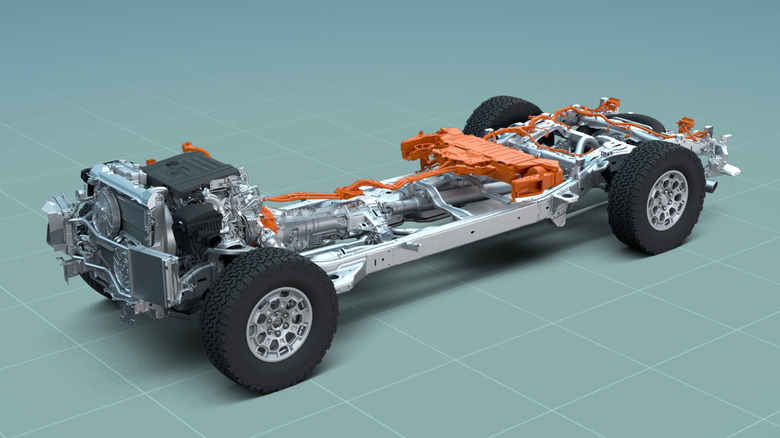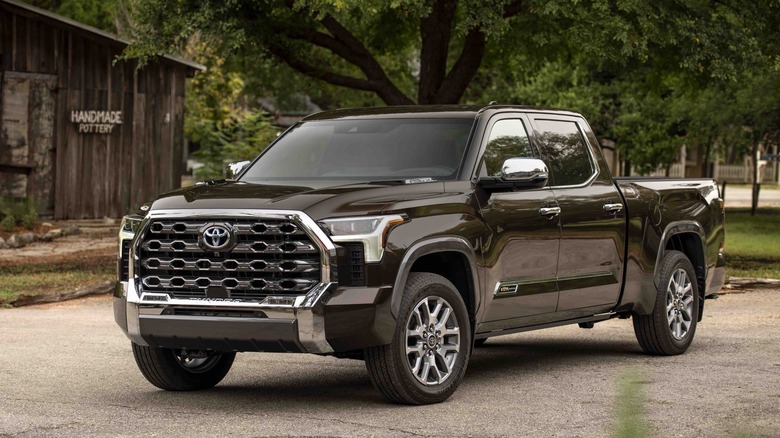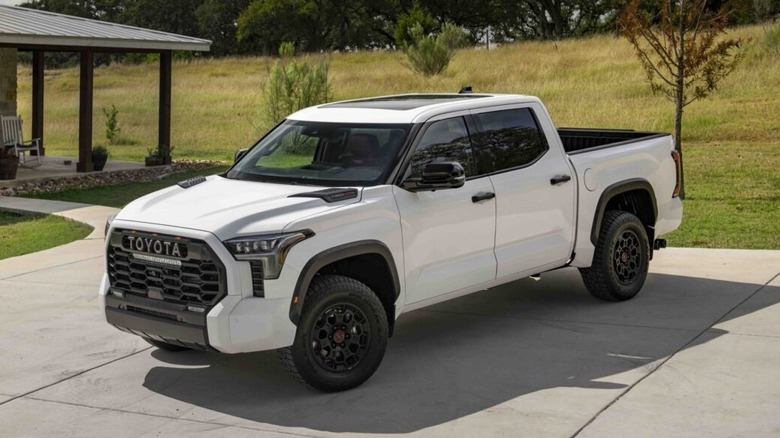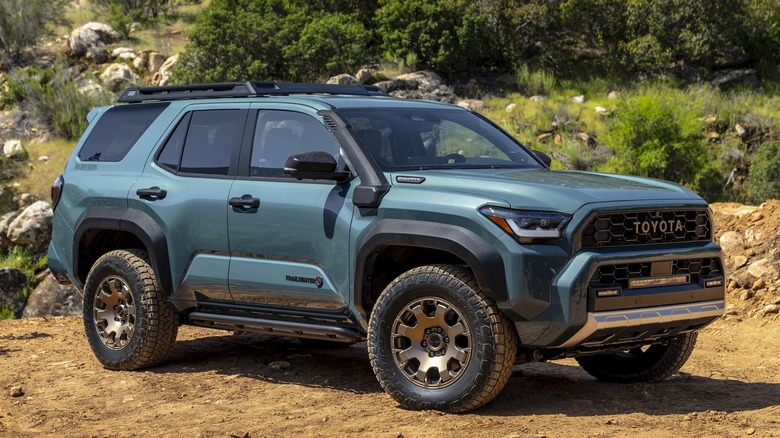Toyota I-Force Max: The Benefits And Features Explained
Toyota, like many automakers, is adding electrified vehicles across its entire lineup. It might not have as many pure EVs as some other manufacturers yet, but it's adding hybrid systems to many vehicles, and in some cases replacing standard internal-combustion engines altogether. Toyota, like other OEMs, is producing hybrids in an attempt to reduce carbon emissions and move closer to carbon neutrality as a company. In search of carbon reduction, there are several vehicles that have received the hybrid treatment lately, including Toyota's biggest trucks and SUVs.
The Toyota Tundra is now available as a hybrid, and it was one of the first Toyota vehicles to use its rough-and-tumble hybrid nomenclature: i-Force Max. Toyota has expanded the use of the i-Force Max name, and it now represents hybrid powertrains in several Toyota vehicles like the Land Cruiser, Sequoia, Tacoma, and 4Runner. But what does this i-Force Max name mean across all these SUVs and pickup trucks? Typically, we think of hybrid powertrains as increasing fuel economy, reducing emissions, and in some cases, adding more power, but does the i-Force Max name live up to those expectations? And how does it compare to outgoing V8s and V6s?
How i-Force Max works in the Tundra
In the 2024 Tundra, the standard powertrain is called the i-Force. It's a twin-turbocharged 3.5-liter V6 that produces 389 horsepower, mated to a 10-speed automatic transmission. That's respectable horsepower for a V6 and certainly enough for most daily tasks, but the hybrid system pumps things up a bit. The i-Force Max uses a 48-horsepower electric motor/generator located between the engine and the transmission. It can add torque to the standard output as the driver demands it, or in some scenarios, it can provide gas-free propulsion for the Tundra. The i-Force max produces a total of 437 hp, a significant increase over the standard V6.
Since the Tundra is no longer available with a V8, the hybrid powertrain needs to make up some ground in the torque department too. The standard V6 makes 479 lb-ft of torque, while the i-Force Max makes 583 lb-ft of torque – over 100 lb-ft more. It's a potent increase and one that certainly makes the Tundra feel more powerful when you put your foot down. It's a solid driving experience, and one that feels like a better replacement for Tundra's old 5.7-liter V8, but does it do more than just add power?
What're the benefits of i-Force Max in the Tundra?
When it comes to towing, some Tundra trims equipped with the i-Force Max powertrain get an increase in towing capacity by about 100 pounds, while in others, max towing is lower than the standard V6, but only by a small margin – about 30 pounds. A four-wheel drive Tundra Limited, for example, one with a 5.5-foot bed, has a maximum towing capacity of 11,120 pounds with the standard V6. The i-Force Max only adds 50 lbs to that number. With the same configuration, in the Platinum trim, towing capacities are 11,050 for the i-Force and 11,020 for the i-Force Max. Essentially, it's a wash. Both powertrains are extremely capable when it comes to towing, but the hybrid won't necessarily mean a higher towing capacity.
Payload is a clearer picture, and it's pretty much a net loss for the i-Force Max. The hybrid system adds weight, which lowers the amount of extra weight the truck can hold. So, payload drops by about 100 pounds in most hybrid models compared to their V6-only-equipped counterparts. Thankfully, fuel economy ratings from the EPA are better across the board. On two-wheel drive models, the Tundra maxes out at just 20 mpg combined. With the i-Force Max however, top trims are rated at 22 mpg combined. It's a similar story with four-wheel drive models – the standard V6 returns as high as 19 mpg combined while the hybrid maxes out with an estimate of 20 mpg combined.
What about other Toyota i-Force Max models?
As mentioned earlier, there are several hybrid-powered Toyota models, but not all of them are given the i-Force Max designation, nor do they all share the same powertrain. The Tundra's three-row SUV sibling, the Sequoia, gets the same i-Force Max powertrain as standard, and it has similar fuel economy ratings to the Tundra — 22 mpg combined on two-wheel drive models and 20 mpg combined on four-wheel drive models. The Sequoia matches the Tundra's fuel economy estimates and its driving characteristics too. While driving the Sequoia, we found it to provide a smooth delivery of power along with its impressive acceleration.
The Toyota Tacoma, 4Runner and Land Cruiser also use i-Force Max powertrains, but not the V6. All three vehicles are built on Toyota's TNGA-F platform and use a version of the turbocharged 2.4-liter four-cylinder engine. In these trucks, the four-cylinder i-Force Max uses a similar 48-horsepower electric motor integrated into the transmission to increase power. The i-Force Max version of the four-cylinder engine is standard on the Land Cruiser, but optional on the Tacoma and 4Runner. With the Tacoma and the 4Runner, it means a jump from a maximum of 278 hp and 317 lb-ft of torque with the standard engine, all the way up to 326 hp and 465 lb-ft of torque (the same numbers it produces in the Land Cruiser). So the i-Force Max system provides big torque numbers no matter what it's powering.
How does the 2.4-liter i-Force Max stack up?
Each of the three 2.4-liter i-Force-Max-powered Toyotas has a unique story to tell when it comes to capability and efficiency. We'll start with the simplest, the Land Cruiser. Previous Land Cruisers were powered by a big, thirsty V8 that was rated at 14 mpg combined. The new model is rated at 23 mpg combined – a massive increase. Towing with the Land Cruiser however, is down, from a maximum capacity of 8,100 pounds down to 6,000 pounds with the new model. Toyota hasn't released fuel economy numbers for the 4Runner yet, but it says the i-Force Max powertrain will give the 4Runner a maximum towing capacity of 6,000 pounds – an increase of 1,000 pounds over the previous-generation model.
With the Tacoma, there are several trims to choose from, with different transmissions and powertrains available depending on which trim you go with. Without diving too deep into the various trim levels, it's sufficient to say that i-Force Max models receive a combined fuel economy estimate from Toyota that's 3 mpg higher than non-hybrid Tacomas. For example — the Limited trim (four-wheel drive only) has an estimate from Toyota of 21 mpg combined, while the Limited i-Force Max gets an estimate of 24 mpg combined. Previous Tacomas with the V6 and four-wheel drive topped out at 21 mpg combined. Towing with standard four-cylinder models tops out at 6,500 lbs, while i-Force Max models are limited to 6,000 lbs.




